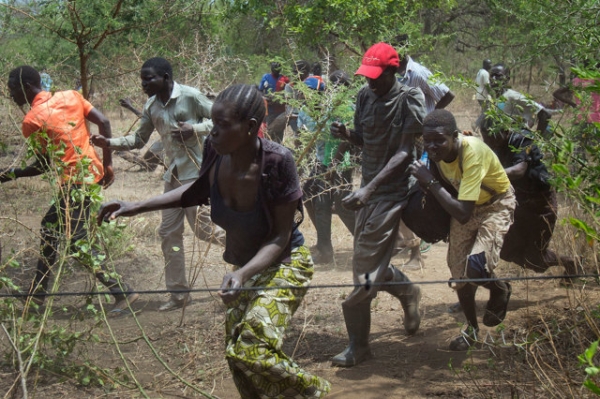Displacement of civilians is, deplorably, a common feature of all armed conflicts. In particular, it can be defined as the process in which people are compelled to flee or to leave their homes or places of habitual residence in order to avoid the effects of armed conflict, including violence. Displacement can have different roots, but not always constitute an indirect consequence of armed conflicts. Rather, it can represent a deliberate strategy of war, likely amounting to a violation of IHL. As explained by the ICRC, it is extremely important to distinguish between the voluntary fleeing or relocation of persons, on the one hand, and the deportation or forcible transfer of civilians, on the other. The first is a regrettable, but unavoidable, occurrence of war, determined by the natural tendency of people to seek refuge away from the battlefield. The second can be defined as the coercive and unlawful uprooting of the inhabitants of a territory, which is, as such, generally prohibited under the law of armed conflict. People’s experiences of displacement differ according to the circumstances that caused them to leave. When people flee as a consequence of war, for instance, they might be displaced for relatively short periods of time. Conversely, targeted IHL violations are more likely to trigger protracted displacement, and/or to make return a more remote option for the people affected. (To know more on this topic, please read: http://www.losservatorio.org/en/civlians-in-conflict/reports/item/1401-displacement-of-civilians-in-times-of-war).
1) Displacement in Nigeria
The deadly attacks and extreme violence in the northwestern state of Zamfara, Nigeria, have forced hundreds of thousands of people to flee their villages and seek shelter on construction sites and within school buildings in the town of Anka. Displaced people here live in abandoned grey concrete structures, with no roof above their heads. “They have lost everything”, says Anja Batrice, a Médecins Sans Frontières (MSF) doctor.
From May to September this year, MSF’s Nigeria emergency team carried out 12,677 outpatient consultations for internally displaced people in Anka town. Most of the children are being treated for malaria, malnutrition and respiratory tracts infections, while others need intensive care. Malaria is indeed the most common disease treated at MSF's paediatric ward inside Anka’s general hospital. With heavy rain falling most days, a large puddle of stagnant water has formed and an ideal breeding ground for mosquitoes has been generated.
MSF continues to provide medical and humanitarian assistance to people in need, but resources are limited and healthcare services are inadequate. “We hope they will all be able to return to their villages at some point” says Anja Batrice.
To know more, please read:
https://www.msf.org/run-violence-nigeria
2) Displacement in Syria
Following the launch of Turkish military operations on Wednesday 9 October 2019, towns and villages along the Syrian border have been subject to heavy shelling. As a result, people are fleeing from the fighting and seeking shelter and safety where they can.
“After eight years of war, the Syrian people have once again been forced to leave their homes and belongings behind in order to seek safety” says Robert Onus, MSF emergency manager for Syria.
MSF is concerned that the many thousands of women and children living in camps such as Al Hol and Ain Issa are also now particularly vulnerable, as humanitarian organizations have been forced to suspend or limit their operations. This could leave thousands of people without access to critical relief, and with no resolution in sight.
To know more, please read:
3) Displacement in South Sudan
“I had to run”, says Chaplain Logonda, while sitting on a blue plastic chair outside his home in the Palorinya refugee camp, in northern Uganda.
“It was an ordinary Sunday morning of January 2017, when I saw government soldiers approaching me in the city of Mondikolok”. There, citizens are often mistaken for opposition fighters. “I had to run”, he continues. Chaplain Logonda ran behind his house, away from the main road and the village market, where he knew he would likely find more government soldiers. He went toward the narrow, beaten pathways through the bushes that lead into farmers' fields, over to the forest, and on to neighbouring villages. “As I was running, the soldiers were shooting. I was falling, they were shooting, I was falling, they were shooting".
South Sudan, the world's newest country, has been in civil conflict for more than five years. Since the collapse of the peace deal in 2016 alone, more than a million people are said to have fled across the border, escaping rape, murder, destruction of property, and occupation of land. Al Jazeera used a mobile phone survey, satellite imagery, submitted photos and public data to try to confirm these reports and shed light on the scale of the conflict. Of the 405 people who answered Al Jazeera's mobile phone survey, more than 40 percent said they had been forced off their land or out of their home since December 2013. Nearly half of those people blamed government soldiers.
"We blame the government, of course. We blame the government because they wanted to push us out," says Joseph Lugala Wani a business man from South Sudan. "If we were to remain there, these houses would not have gotten burned." The army however denies responsibility. South Sudan's information minister, Michael Makuei, told Al Jazeera burned homes were a "normal consequence" of war.
To know more, please read:
https://interactive.aljazeera.com/aje/2019/south-sudan-forced-out/index.html




